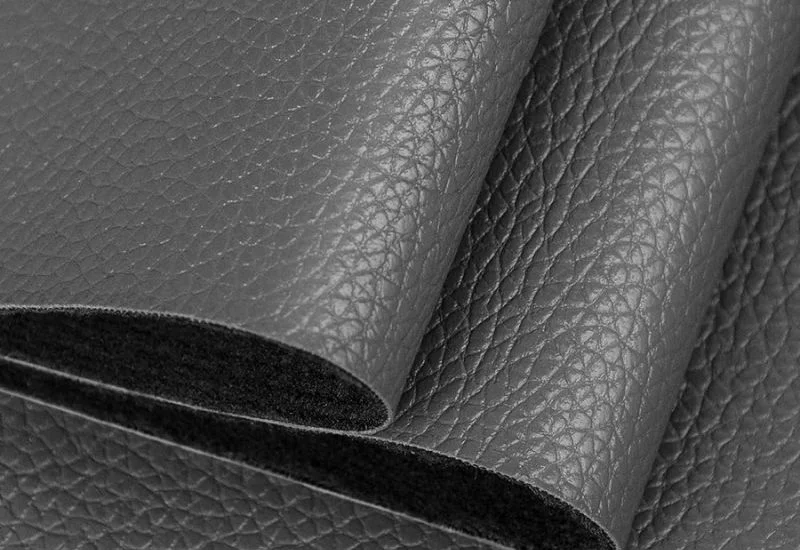
Edited by Abdullah Faraz on July 10, 2024
PU leather is an artificial type of leather generally used in place of genuine leather. It is made by a combination of polymers that give it a shiny appearance. It is cost-effective and easy to manufacture.
PU leather is vegan, meaning its production harms no animals. It is environmentally friendly, but only to some extent.
In this article, we will discuss the manufacturing process of PU leather, the pros and cons of PU leather, and the uses of PU leather in various industries. We will also briefly cover the effects of PU leather on the environment. Now, let’s begin.
Synthesis of PU leather
As the name suggests, PU leather is made from a polymer known as polyurethane (PU). Polyurethane is a mixture of two compounds mixed under certain required conditions. Polyol and di-isocyanate are mixed in a specific amount, resulting in polyurethane synthesis1. It is just the initial process of manufacturing PU leather. This crude product is also usable in generating other valuable products.
Coating
A fabric is used as a backing material for the polyurethane. The fabric supports the product, and the polyurethane remains on top, giving the leather a shiny appearance.
The backing material and polyurethane are coated with silicon under a roller plate, making the mixture thick and smooth. The texture can later be added to the bi-cast leather product to enhance its shiny appearance.
Embossing
The backing material is coated with polyurethane, and then embossed with a texture that matches the genuine leather. It resembles grain or animal hide. An embossing roller plate is used for this purpose. It is convenient for giving a smooth texture to the raw product.
Finishing
It is an essential step in making PU leather look good. The final coat decides what texture will be given to the whole batch. The shiny, matte and genuine-leather type textures are preferred while coating the final layer of material.
PU leather is synthesized using numerous chemicals and energy sources. However, the process has many environmental concerns, as it causes plastic pollution, and the manufacturing process makes it non-biodegradable2.
Advantages of PU leather

PU leather has many benefits over genuine leather. The increasing demand for PU leather is also a major factor.The market value of synthetic leather was more than USD 40 billion in 2024. It is on a constant rise, and market experts predict that it can reach up to USD 90 billion by 20333.
Evidently, PU leather is in demand by manufacturers and customers, but Why?
PU leather is synthesized using various procedures, and because of that, its quality is ultimately decided. We are going to discuss some general advantages of PU leather over other materials.
Economical
As it is made of synthetic materials, it does not cost too much. The cost-effective nature of polyurethane leather makes it a popular material in the market. It is waterproof and tear-resistant, which increases its use in various home or outdoor products.
Another factor is that the industries produce polyurethane in large amounts that gives a lot of profit to them. Regular supply increases the daily production that is a plus point for the industries.
Versatile
PU leather is one of the most versatile materials, used in the synthesis of various daily essentials. Other leathers are only available in limited color ranges, but PU leather provides a variety of color options to both manufacturers and customers.It can be made in any color, gradient, or style, depending on the coating process.
Vegan-friendly
For those who are concerned about the use of animal skins for various products, this product is a great alternative. People avoid using genuine leather because of their ethical beliefs.This leather gains much attention as it is completely synthetic and free from animal hides. This makes it a more sustainable option4.
Desirable Physical properties
During the manufacturing process, it is easy to alter the physical and chemical properties of the final product. In this way, the industries provide on-demand leather to its customers. It makes it cost effective and versatile as compared to other synthetic materials.
It is softer and lightweight than genuine leather material. It is resistant to ultraviolet (UV) radiations that increase its demand in comparison with genuine leather that is less resistant. You can also make it waterproof to some extent.
Durable
Normally, cracks and lines appear on the leather as we use them for a long time. This will not happen with polyurethane as it is resistant to wear and tear. It depends on the quality of the polyurethane. High-quality synthetic leather is able to withstand its original shape and shine for many years without any cracks. It makes it durable and long-lasting.
Disadvantages of PU leather

Look & Feel
The use of polymers in the formation of PU leather material gives it a plastic-like appearance. The unique granular texture and feel of the leather are missing. Making it look like genuine leather demands a lot of attention and pure chemicals in the manufacturing process. People easily find it different as compared to genuine leather material.
Breathability
It is a non-porous material which means it does not allow the crossing of air. It also affects the shelf life of the material. This makes it uncomfortable to use for a long period of time. It is also recommended to not use it in hot weather. People living in humid areas generally avoid the use of this material.
Odor
Using chemicals such as solvents and polymers gives off a bad smell. The smell of plastic is evident in all PU leather-based products. It causes frustration and limits its use. Consumers avoid using such products as they are difficult to discard and make their places smell bad. In some scenarios, the smell fades over time but it requires the use of pure chemical substances.
Environmental effects
This synthetic leather material is a significant source of environmental pollution due to the extensive use of harmful chemicals. Solvents like dimethylformamide and other polymers cause pollution and disrupt the natural environment. If you are concerned about the environment, you prefer more organic products.
Shelf life
If handled properly, the synthetic leather material lasts up to eight to ten years. It is much lower than the shelf life of genuine leather products. Genuine leather products have lifetime usability when used nicely.
Summary
| Advantages of PU Leather | Disadvantages of PU Leather |
| It is economical | Plastic-like appearance |
| Versatile; used in various objects | Less breathability |
| Vegan-friendly | Odor |
| Durable | Not environment friendly |
| Desirable physical structure | Less shelf life than leather |
Uses of PU leather
Automotive Industries
You often wonder how vehicle manufacturers can afford leather interiors. It is because they use synthetic leather-like polyurethane to give an aesthetic look to the interior of their vehicles.
Dashboards, seats, cushions, steering wheels, etc. are all covered with polyurethane products. It gives them a glossy and shiny appearance. It is affordable and easier to maintain as well.
Bags
Bags is a huge market where synthetic materials are utilized in the manufacturing process. A bag is available in various price tags depending on the material that is used in its fabrication. It is affordable and easy to care for. It is often indistinguishable as compared to genuine leather bags.
Furniture
PU leather is widely used in the furniture industry. Various chairs, sofas, ottomans, and couches are fabricated using this synthetic material. Genuine leather stuff is expensive for a lot of customers. This is an excellent alternative as it is more affordable and more accessible to maintain.
Shoes
Leather is extensively used in the manufacturing of shoes. Mass production of artificial leather can be seen in shoes industries. Genuine leather shoes are very expensive and many people cannot afford them.
Artificial leather materials are used in the manufacturing of shoes. It makes them shiny and smooth and attracts a lot of customers. It requires proper cleaning to increase its durability.
Other Accessories
It is also used in the formation of various small accessories, including wallets, mobile cases, laptop sleeves, belts, watch straps, etc. Sometimes, it is difficult to tell the difference between actual leather and synthetic leather products. It makes the accessories cheaper5.
How to Care for PU Leather Products

Synthetic leather products require care to increase their shelf life. It is softer than genuine leather and requires a proper cleaning process. It is easy to care for synthetic leather products.
Cleaning
Mild soap, soft microfiber cloth, and warm water are required to properly clean the polyurethane leather products. There is no need to use leather conditioners in the cleaning process.
Avoid the use of excessive water and soap as it damages the outer surface of the leather. Always use damp cloth to clean the surface gently.
Maintaining
Proper, regular cleaning is necessary to maintain synthetic leather products. Wipe off any dust on the outer surface and apply a coating to protect the shine of the leather material.
It is also not feasible to place the products in direct sunlight for a more extended period. It causes the formation of cracks, and the leather may disintegrate over time.
Comparison between PU leather and Faux leather

There is not much to differentiate between the polyurethane leather and faux leather. The primary distinguishing factor between the two is their manufacturing process.
Synthesis material
Both materials are manufactured using synthetic materials like fibers and polymers. PU leather specifically uses polyurethane in its fabrication, which gives it a smooth texture. Faux leather is a somewhat broader term. Many polymers, like PU, PVC, etc., fall under this category6.
Quality
PU is softer as compared to faux leather. Faux is specifically designed to look like genuine leather but polyurethane has its own characteristic features. It is more shiny and non-porous. PU material is more durable than faux leather material.
Comparison between PU leather and Genuine leather
It is difficult for some people to differentiate between the two leather products. Nowadays, a lot of products are available that use PU leather material in their manufacturing. Knowledge of synthetic and genuine leather is essential before purchasing any kind of product.
Price
Genuine leather will be more expensive than synthetic leather products. Vegan-friendly leather products are generally cheaper as compared to leather made of animal hides.
Always look for a price tag before purchasing any product as it gives you a broad opinion about the type of material used in the manufacturing process.
Appearance
Polyurethane leather has a uniform and solid color-like appearance. On the other hand, genuine leather is not uniform and often has color variations in the finished product. It is because of the natural look of the genuine leather.
Texture & Smell
Genuine leather gives off a distinctive odor that is different from other weather products. PU leather has a plastic like smell as it is made of synthetic materials.
Genuine leather has a granular texture and is soft to the touch. Polyurethane is a smooth material with no grains due to the synthetic chemicals.
Water drop test
As described earlier, polyurethane leather material is non-porous. It means that if you place a drop of water on its surface, it will not absorb it. Genuine leather has countless fibers in its surface that absorb the water.
Flame test
You can also perform a flame test to check the product’s authenticity. The test requires a safe environment. PU leather usually burns and melts in the presence of flame because the polymeric substances liquefy, causing them to melt.
Genuine leather did not melt; instead, it burned like wood. Verifying the material used is essential if you are dealing with an industry or many types of products.
Environmental Impact of PU Leather Material

Synthetic leather materials are more sustainable than genuine leather products, but there are drawbacks to using these materials. It greatly influences the environment. Synthetic leather materials are non-biodegradable, which means that they are not easy to get rid of.
People often use recycling as a plus point to sell artificial leather products. It is a useful feature, but not all areas have the same facilities for recycling synthetic products. They dispose of the products in open lands that cause environmental pollution7.
Artificial leather products take years to decompose. They pollute the land in an easy way to compensate for. Burning of fossil fuels is also a major risk factor in the manufacturing of these materials.
Before manufacturing artificial materials, always look at the broader picture, whether it will disrupt the environment or not. Climate change is a big dilemma that must be addressed in every field.
Conclusion
PU leather is a synthetic leather material made by using solvents and polymeric substances. It offers flexibility and affordability to the customers. A wide range of products like shoes, bags, wallets, belts, etc. are synthesized using artificial leather material.
PU leather is a budget-friendly alternative to genuine leather products. It is cost-effective and can be used in the long run if handled with care.
The choice of artificial leather products depends on a lot of factors. This article extensively explains the essential PU leather material before purchasing synthetic leather.
Frequently Asked Questions
Article Sources
Bagsbucks provides reliable information with good-quality references to support the facts.
- Recent advances in functional polyurethane and its application in leather manufacture: A review.mdpi ↩︎
- What is PU Leather? The Pros & Cons.ChairOffice ↩︎
- Synthetic leather market size to be worth USD 90.89 Billion by 2033. Yahoo Finance
↩︎ - 10 advantages of pu leather.BZ Leather Company ↩︎
- Classification of synthetic polyurethane leather by mechanical properties according to consumers’ preference for fashion items.springerlink ↩︎
- What is PU leather – And why you should avoid! .Manuel-Dreesmann
↩︎ - Recent advances concerning polyurethane in leather applications: An overview of conventional and greener solutions.springerlink
↩︎
